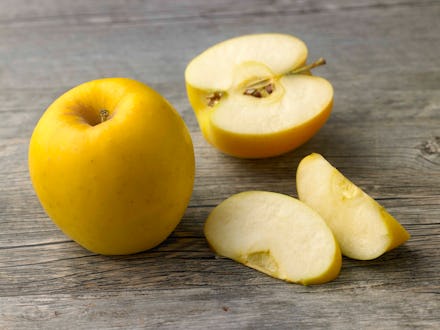The Opal, a “non-browning apple” is here — and it’s made without any GMOs

It won’t screen your calls, let you hate-watch Instagram stories or track your steps, but the apple of the future is here. We’re talking fruit, of course: A new-ish apple variety called Opal stands out in the produce section not just for its stunning golden hue, but for its ability to stay fresh much longer than others.
Opals are the only non-browning apple grown in the U.S. Opals only started to be widely distributed in 2015 — and from the end of October through June, you can find them at most major retailers. They’re the only apple to be certified through the non-GMO project, if GMOs are a concern.
Opals were created naturally by crossbreeding the Topaz apple and the Golden Delicious apple, Paul Esvelt, post harvest manager at Broetje Orchards said over the phone. Topaz and Golden Delicious turned out to be a winning pair. Different varieties of apples have different amounts of a chemical called polyphenol oxidase, which is the compound that releases the enzyme that causes browning, Esvelt said. “Just through sheer luck in the breeding process, the Opal actually has a low rate of that particular chemical. It still does brown eventually but it browns really slowly.”
It’s one thing to claim an apple is slow to brown, but it’s another to put it to the test. So we did that. We compared the browning of a cut Opal to the browning of a cut Gala, because that’s the kind of apple we have here at the Mic offices.
Opal and Gala apples — freshly sliced
About two hours later
About 10 hours after the apples were first sliced
These apples were left out over night, all alone.
Apple closeup
As you can see, the Opal does appear to brown more slowly than the Gala. While the difference isn’t earth-shattering, it is apparent.
In case you were wondering, it’s completely natural for apples to brown once they’re cut open and exposed to the air, and browning apples are safe to eat, Esvelt said. But we have high standards for the way our food looks. Because Opals take longer to turn, Esvelt said they’re particularly great for slicing up and packing for children’s lunches. “[My kids] actually eat it because it doesn’t get all soupy and soppy,” he said.
Beyond its lasting freshness, the Opal is crisp, tart and incredibly firm. Apple harvesters use a tool called a penetrometer to calculate the firmness of fruit. “It measures the resistance to the flesh of a calibrated plunger,” Esvelt said. “The Opal typically has anywhere from 16 to 20 pounds of resistance.” The Honeycrisp, by comparison, typically has 11 to 14 pounds of resistance, according to Esvelt.
The Opal’s firmness lends itself to excellent baking possibilities. “It’s fantastic because it retains the integrity of the apple pieces in [pie],” Esvelt said. “If you like the apple texture in your baked goods, it does a good job at that — you get a smooth consistency.”